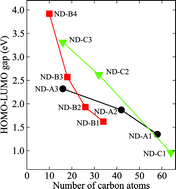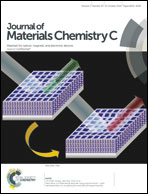Tuning the optical response in carbon doped boron nitride nanodots
Abstract
Time dependent density functional theory and the hybrid B3LYP functional are used to investigate the structural and optical properties of pristine and carbon doped hexagonal boron nitride nanodots. In agreement with recent experiments, the embedded carbon atoms are found to favor nucleation. Our results demonstrate that carbon clusters of different shapes promote an early onset of absorption by generating in-gap states. The nanodots are interesting for opto-electronics due to their tunable optical response in a wide energy window. We identify cluster sizes and shapes with optimal conversion efficiency for solar radiation and a wide absorption range form infrared to ultraviolet.


 Please wait while we load your content...
Please wait while we load your content...